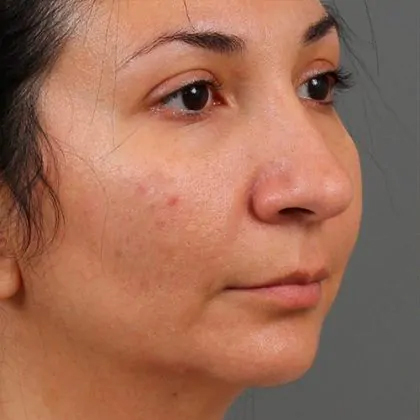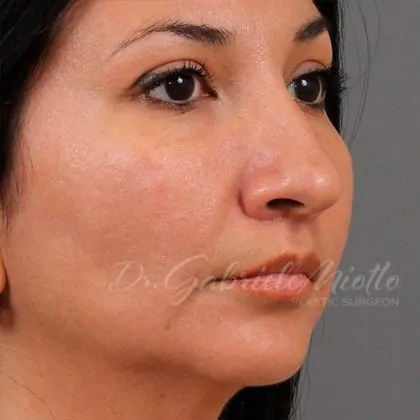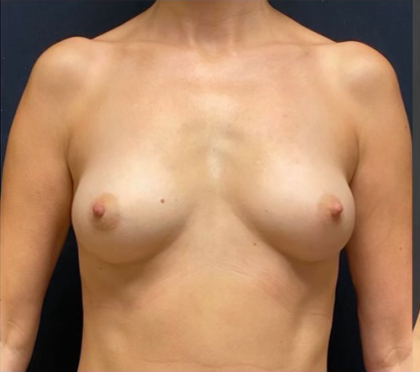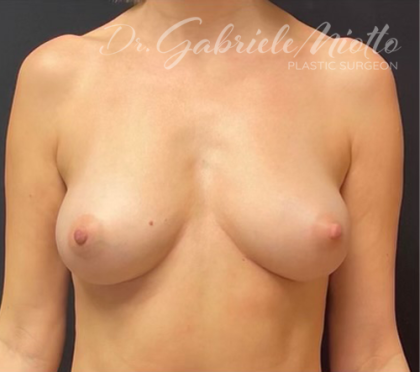Fat Transfer Breast Augmentation
Conveniently located to serve the areas of Atlanta, GA
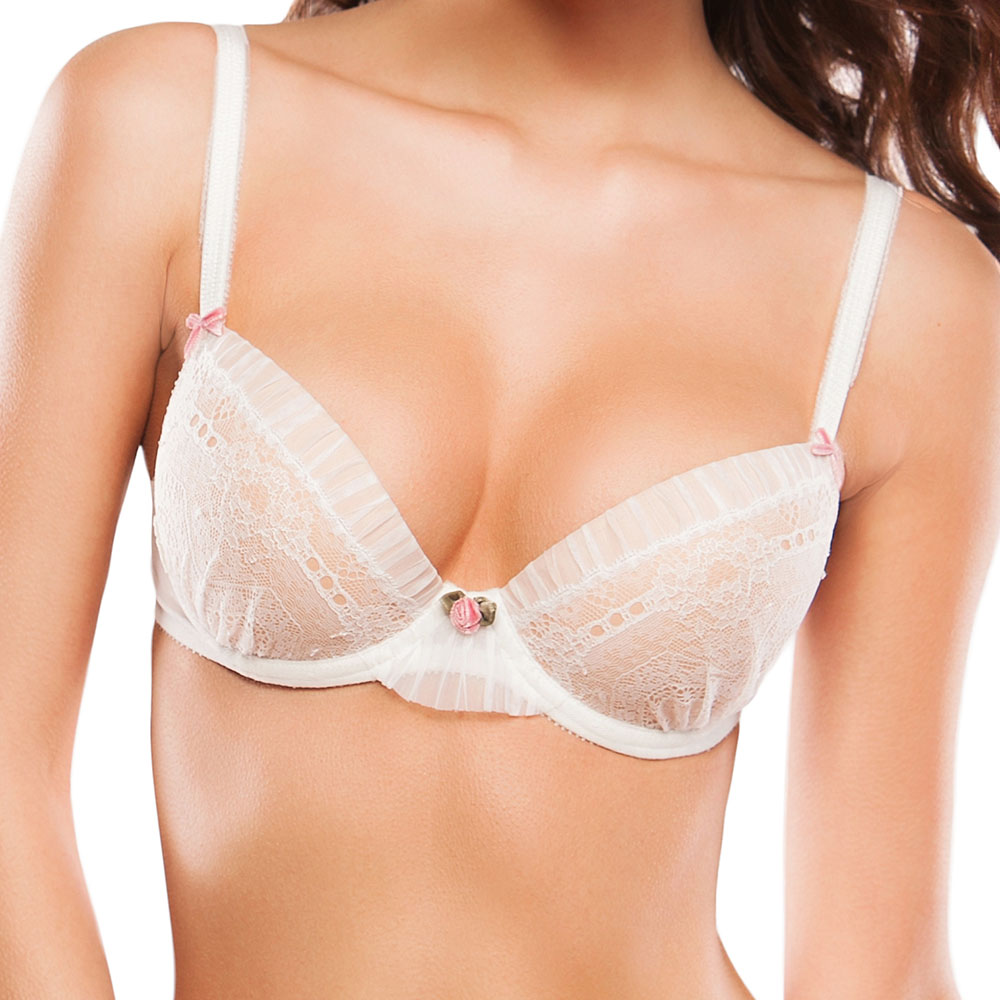
Fat transfer to the breasts is an ideal procedure for those who want a mild, more natural improvement in the breast size, but do not want a breast implant. Transfer of fat from the other areas of the body to the breasts adds a secondary benefit of removing unwanted, excess fat from the trouble areas such as the abdomen, legs and arms.
Contents
- 1 Before and After Photos
- 2 After procedure
- 3 General preoperative recommendations
- 4 General postoperative recommendations
- 5 Activity
- 6 Bathing
- 7 Returning to work
- 8 Diet
- 9 Final results
- 10 Fat transfer specialist
- 11 Fat Transfer Augmentation
- 12 What are the benefits of an atlanta autologous fat breast augmentation?
- 12.1 Longer lasting results
- 12.2 The body does not reject its own fat cells
- 12.3 Short incisions
- 12.4 During transfer, Dr. Miotto uses specially designed cannulas
- 12.5 Contouring of the areas Dr. Miotto uses for harvesting
- 12.6 Areas that plastic surgeons frequently harvest fat from for breast enhancement include the
- 13 Aging and Breast Changes
- 14 Who should consider having an autologous fat breast augmentation in atlanta?
- 15 A good candidate
- 16 Fat Grafting vs. Traditional Augmentation
- 17 Combination Breast Enhancement
- 18 Advantages and Disadvantages
- 19 Advantages
- 20 Disadvantages
- 21 An initial consultation
- 22 Preparing
- 23 Recovery
- 24 What to expect
- 25 Results
- 26 Risks
- 27 FAQ
- 27.1 What is fat transfer or fat grafting for breast augmentation?
- 27.2 How is a fat transfer surgery performed?
- 27.3 Would I be able to combine a fat transfer with a larger liposuction?
- 27.4 Do I need to be sedated during the fat transfer?
- 27.5 Is fat transfer to the breast safe?
- 27.6 How long does fat transfer last?
- 27.7 Will there be swelling after fat transfer surgery?
- 27.8 What is breast fat transfer recovery time?
- 27.9 Am I a good candidate for fat transfer?
- 27.10 How can I get started to learn more?
- 27.11 How much will a fat transfer breast augmentation in atlanta cost?
Before and After Photos
After procedure
Fat transfer is an outpatient surgery done under general or local anesthesia.
Fat transfer is not a painful procedure, but mild discomfort and feeling of tightness due to swelling is expected for a few days to a few weeks after surgery. However, it can be treated with preoperative and postoperative medication and supplementation, ice and anti-inflammatories. We are all different, so it is hard to predict who will get more or less swelling and bruising.
General preoperative recommendations
What to avoid before surgery
- DO NOT take any aspirin for 7-10 days before your scheduled procedure. Do not take NSAIDS (Aleve, Motrin, Ibuprofen) for 5 days before surgery. You may take Tylenol (Acetaminophen) if needed for aches or pains. Please contact the office at if you have any questions about any medications that you are taking or if you are prescribed aspirin by your cardiologist or Primary Care Provider (PCP).
- Discontinue Vitamin E 10 days before surgery.
- Avoid the following herbal supplements for 10 days before surgery: Echinacea, Ephedra / Phentermine (used for weight loss), Feverfew, Fish Oils, Garlic, Ginkgo Biloba, Goldenseal, Kava-Kava, Licorice, Saw Palmetto, St. John’s Wort and Valerian.
- Stop Smoking. The harmful effects of smoking can cause tissue death, infection, and open wounds. It also makes you age faster!
- Alcohol can promote swelling of the surgical area and it is best to avoid alcohol intake for at least one week before surgery.
What to take before surgery
- Dr Miotto will prescribe some supplements and medications to help your body heal and to speed up recovery when you come for your preoperative visit.
General postoperative recommendations
- You MUST have a responsible adult to transport you home and stay with you for a full twenty-four hours after your surgery if you had general anesthesia
- You will be unable to drive if you are taking narcotics.
- It is common to feel sluggish for a few days as the anesthesia works its way out of your system.
- Your initial post-operative appointment will be scheduled by your Patient Care Coordinator.
Activity
- Please refrain from physical activity that will increase your heart rate or blood pressure for 2 weeks after surgery. However, bed rest is NOT recommended, and you should be walking at normal pace after the procedure.
- Frequent walking will decrease the risk of post-operative blood clots after a long surgery (mostly after general anesthesia).
Bathing
- You can shower twenty-four hours after surgery. You may clean the incisions as instructed by Dr Miotto or her nurses after the procedure.
- Do not submerge yourself into a tub/pool until all wounds have healed (usually in 3 weeks).
- Do not scrub the surgical sites, however you can allow soapy water to run over them.
- Avoid lotions on the surgical sites for 2 weeks, but you can moisturize any other areas as desired.
Returning to work
- Recovery time will vary; however, most patients return to work within one to 2 weeks after the procedure, within one week you will have a feel for your specific limitations and will be able to determine how comfortable you will be with resuming your daily activities and workload.
Diet
- Immediately following surgery, it is best to eat bland, easily-digested food and avoid excess sugar and salt. Healthy proteins (eggs, lean meat, beans, nuts), rice, fruits and cooked vegetables (broccoli, peppers, sweet potatoes) will provide your body with nutrients essential for healing.
- Eat a few bites of food before taking pain medications as these can cause nausea.
- A diet low in sodium will help minimize swelling and water retention.
- Drink plenty of water! Drinking low sugar sports drinks and protein shakes are recommended.
Final results
- Keep in mind that our goal in aesthetic surgery is improvement and not perfection. You will be followed closely after surgery to assure that you heal well and have the best possible results.
- It can take months for the very final results of your surgery be apparent. After 12 weeks, you can expect your results to be mostly permanent. Expect subtle changes in swelling and healing (including the appearance of scarring) to continue to appear for up to twelve months.
- It is important for you to keep open communication with your physician and return for your follow up visits. We will take pre and post pictures along the way and look at the final results together.
Dr. Gabriele C. Miotto is a Brazillian-American plastic surgeon specialized in aesthetic surgery and minimally invasive procedures, specially of the face, eyes, nose, breast and liposuction. Call (404) 850-5851 for your consultation.
Fat transfer specialist
Women in and around Atlanta who would like to address slightly droopy breasts and want to increase the size of their breasts by as much as one cup, should consider a breast augmentation via structural fat grafting. A fat transfer breast augmentation (aka an autologous breast augmentation, autologous fat breast augmentation, breast augmentation with fat transfer) refers to the procedure where a plastic surgeon increases the size of a woman’s breasts using her own fat. The surgeon harvests a patient’s fat and purifies it before transferring the fat into specific areas of the patient’s breasts to create the aesthetic changes that she desires. At ME Plastic Surgery, Dr. Gabriele Miotto, a top plastic surgeon and expert injector in Atlanta, helps women attain the beautifully shaped, larger, lifted and symmetrical (i.e., even) breasts they desire with autologous breast augmentations.
Fat Transfer Augmentation
During an autologous augmentation of the breasts, the Dr. Miotto uses liposuction to remove excess fat from areas of the patient’s body that tend to be resistant to diet and exercise (e.g., inner thighs, love handles, abdomen).
After she harvests the patient’s fat via liposuction, Dr. Miotto uses centrifugation to process it. This centrifugation process separates the weak fat cells from the stronger ones, which allows the plastic surgeon to collect the strongest fat cells for transfer. Using these fat cells, Dr. Gabriele Miotto addresses several aesthetic issues.
With this revolutionary breast enhancement procedure, Dr. Miotto can
- Improve the shape of the breasts.
- Raise slightly sagging breasts (i.e., grade 1 ptosis).
- Increase the size of the breast (by as much as one cup).
- Correct asymmetrical (i.e., uneven) breasts.
In addition, Dr. Miotto can use the patient’s harvested fat to cover up a visible breast implant. Furthermore, a patient who has a gap at the top of her bra can benefit from a fat transfer breast augmentation. Dr. Gabriele Miotto addresses this issue by transferring fat to the area causing the gap. This transfer of fat increases the volume in that area of the breast. While this helps the patient fill out her bra size, the size of her breasts has not necessarily changed.
What are the benefits of an atlanta autologous fat breast augmentation?
Longer lasting results
Autologous augmentation of the breasts offer patients longer-lasting results than the current silicone and saline breast implant options that are available. According to manufacturers, the average lifespan of a breast implant is 10 years. Therefore, at the 10-year mark, many women choose to have their breast implants exchanged for one of the newer implant options available. Nonetheless, the fat that survives after the plastic surgeon harvests, processes and transfers it remains in the breast indefinitely. Since Dr. Miotto expects some of the fat cells that she transfers to die, she transfers slightly more fat cells than the patient actually needs.
The body does not reject its own fat cells
A fat transfer breast augmentation is a more natural procedure than an augmentation with breast implants is. Since Dr. Gabriele Miotto harvests the fat cells she uses to enhance the breasts from the patient herself, the body automatically accepts these fat cells. Therefore, concerns related to the body rejecting this material, considering it an intruder, are of no consequence.
Short incisions
An autologous augmentation requires smaller incisions than a traditional augmentation mammoplasty. Furthermore, the incisions that Dr. Gabriele Miotto makes to harvest the fat and transfer it to the patient’s breasts are only 4 millimeters long. She creates these incisions within the folds of the breasts and along the edges of the nipple-areolar complex.
During transfer, Dr. Miotto uses specially designed cannulas
As she deposits the fat, Dr. Gabriele Miotto uses specially designed cannulas. Using these cannulas allows her to deposit the fat superficially, helping to avoid irregularities and the depositing of too much fat into one area. With strategic placement, once the fat cells create their own blood supply, the patient’s breasts are slightly larger, symmetrical and uplifted. Furthermore, the breasts look and feel natural.
Contouring of the areas Dr. Miotto uses for harvesting
Patients who opt for an augmentation using their own fat enjoy the benefit of Dr. Gabriele Miotto contouring the areas from which she is harvesting the fat for transfer, thus enhancing the overall appearance of these troublesome areas.
Areas that plastic surgeons frequently harvest fat from for breast enhancement include the
- Inner thighs
- Abdomen
- Outer thighs
- Calves
- Knees
- Love handles (muffin top)
- Flanks
- Arms
Aging and Breast Changes
Although aging affects the size of the breast, it also negatively affects the breast’s skin by reducing its elasticity. This loss of elasticity causes the breasts to sag. If the sagging and tissue loss in the breast is minimal, an autologous augmentation may be able to address these issues.
Who should consider having an autologous fat breast augmentation in atlanta?
Most women who would like a slight increase in the size of their breasts are good candidates for a breast enhancement procedure using their own fat. Nevertheless, a potential candidate for this breast enhancement procedure must meet certain criteria.
A good candidate
- Is in good healthSince there are numerous conditions that have no effect on surgery, a medical condition, in and of itself, does not disqualify a patient from candidacy. The only conditions that may affect a patient’s candidacy are those known to increase the risk of surgical complications (e.g., kidney disease, heart disease, hypertension) and those that may negatively affect the body’s ability to heal (e.g., diabetes). Many times, even these conditions do not automatically disqualify a patient from being a good candidate for a fat transfer breast augmentation. Dr. Gabriele Miotto considers the patient’s current health status as the most important factor. For this reason, it is vital that patients are honest about any chronic conditions or health issues they are experiencing.
- Wants the contouring of her breasts to appear more youthfulThe natural aging process affects the breasts in a variety of ways. Whereas, some women experience an increase in the size of their breasts due to an accumulation of excess fat, other women experience deflated-looking breasts that sag. These sagging, deflated-looking breasts may develop following pregnancy, weight loss or simply as part of the natural aging process. Women experiencing slight volume loss and a minimal amount of sagging may benefit from a fat grafting for breast enhancement.
- Would like to correct asymmetrical breastsAlthough uneven breasts are relatively common, some women who have asymmetrical breasts feel subconscious. When there are only slight differences between the breasts, Dr. Miotto may be able to create symmetry by lifting up and increasing the size of the smaller breast with an autologous fat breast augmentation.
- Has had a mastectomyA woman may have a mastectomy due to the existence of breast cancer or as a preventive measure because breast cancer runs in her family. Since a mastectomy significantly decreases the volume of the breasts, many women decide to have a breast augmentation to restore this lost volume. Although a full breast restoration requires the use of implants, combining a traditional augmentation with a fat transfer breast augmentation allows Dr. Gabriele Miotto to strategically transfer the patient’s harvested fat into her breasts. Using this fat Dr. Miotto reshapes and slightly lifts the patient’s breasts. Patients also benefit from Dr. Miotto removing some of the excess fat and contouring the areas she uses for fat harvesting.
- Has lost a substantial amount of weightWhile losing a significant amount of weight is extremely beneficial for a patient’s overall health, some women feel disheartened because of the breast volume they lost throughout the weight loss process. Nonetheless, women who only need a slight increase in the size of their breasts or a minor breast lift may be good candidates for a breast enhancement procedure using autologous fat.
- Wants her pre-pregnancy breasts backThe hormonal changes and rapid weight gain associated with pregnancy frequently wreak havoc on the body of the mother-to-be. The breasts are especially vulnerable to change. As the breasts begin filling with milk, they become heavier, which may cause them to sag. If a mother chooses to breastfeed, once she is done breastfeeding and stops producing milk, her breasts may appear deflated and begin to droop. These changes occur due to the stretched skin and extra tissue resulting from pregnancy, milk production and the breastfeeding process itself. With fat grafting, Dr. Miotto improves the appearance of the breasts. Increasing their size and lifting them to provide the patient with larger breasts that no longer sag.
Fat Grafting vs. Traditional Augmentation
A fat transfer breast augmentation offers patients a very different outcome than the traditional augmentation mammoplasty using breast implants. A breast enhancement using autologous fat only provides the patient with slightly larger breasts and minimal shape changes. A traditional augmentation mammoplasty with breast implants provides a patient with a substantial increase in the size of her breasts as well as visible changes in their shape.
Combination Breast Enhancement
Dr. Miotto can perform an autologous fat breast enhancement procedure in conjunction with other plastic surgery procedures. For example, if a patient’s breast sag quite a bit, she may want to restore the position and shape of her breasts. Dr. Gabriele Miotto uses a breast lift to restore the breasts’ position and shape, and with the fat transfer, she increases the volume of the breasts (up to one cup). This combination procedure provides the patient with slightly fuller, beautifully shaped breasts and a more youthful profile.
Advantages and Disadvantages
Before having an autologous fat breast enhancement procedure, women need to consider what results they expect, as well as the potential long-term effects associated with transferring purified fat into their breasts.
Advantages
- Small incisions.
- No need for an implant.
- Autologous fat serves as the material to increase the size of the breast.
- Breasts feel natural.
- Extremely safe procedure with a low complication rate.
- Breasts look natural.
- Doctors and patients are typically happy with the results.
- The surgeon removes fat from troublesome areas for transfer.
Disadvantages
- Limited enlargement (only up to one cup).
- There is not a standard fat grafting for breast enlargement technique. Therefore, a patient needs to choose an experienced plastic surgeon to perform her fat transfer augmentation.
- The body may reabsorb the transferred fat.
- The patient may still need to have a breast lift.
- If fat necrosis results, imaging tests may mistake these small masses for cancer. These hard masses may be short-lived or remain in the breast permanently.
- The patient must have an adequate amount of fat to transfer to her breasts.
- Calcifications might interfere with the imaging tests that look for breast cancer.
An initial consultation
Women in the Atlanta area who are interested in enhancing their breasts with a fat transfer should contact ME Plastic Surgery to schedule an appointment with Dr. Miotto.
Patients need to provide the doctor with information about their previous surgeries, current medications, health conditions and allergies. In addition, patients who take daily vitamins and herbal supplements need to provide Dr. Gabriele Miotto with this information. Furthermore, patients who use products that contain nicotine, who drink alcoholic beverages or participate in recreational drug use must inform the doctor of these practices. This information is important because nicotine is a vasoconstrictor that can slow healing and alcohol can increase inflammation.
The patient needs to let Dr. Gabriele Miotto know what she wants to accomplish with a breast enhancement procedure using autologous fat. Patients should feel free to ask doctor any question they have during this initial consultation. Some of ME Plastic Surgery’s patients find it helpful to create themselves a list of questions to bring to the initial consultation.
If Dr. Miotto believes the patient is a good candidate for a breast enhancement with autologous fat, she will examine the patient’s breasts as well as any potential fat harvesting sites. Dr. Miotto or her assistant may take photos of the patient’s breasts and potential fat harvesting sites. The photos are taken from various angles. Dr. Gabriele Miotto uses these photos as she creates the patient’s personalized fat transfer breast augmentation surgical plan. These photos are confidential, so they remain in the patient’s medical file.
Dr. Gabriele Miotto creates her patient a surgical plan detailing the way the patient wants her breasts to look and the areas of the body that the patient would like her to use while harvesting the fat for transfer.
Preparing
Dr. Gabriele Miotto provides her patients with a list of medications, herbal supplements and vitamins to avoid prior to surgery. Abiding by her recommendations is crucial to ensuring optimal results.
An autologous fat breast enhancement is an outpatient procedure, which means that after spending some time in the recovery area, patients are able to return home. Patients receiving twilight anesthesia or general anesthesia during their autologous fat breast enhancement procedure are unable to drive for at least 24 hours after receiving these medications; therefore, patients need someone to drive them home after their procedure. In addition, patients need to ask someone they trust and feel completely comfortable with to stay with them overnight.
Following any procedure requiring the use of sedation or anesthesia, for safety’s sake, public and for-hire transportation services are unacceptable forms of transportation.
Patients receiving twilight sedation or general anesthesia need to fast the night before their breast enhancement procedure. Fasting time is usually 12 hours. During this 12-hour timeframe, patients must refrain from eating and drinking. Therefore, if a patient usually takes medication during this 12-hour timeframe, she should discuss this with Dr. Miotto for direction ahead of time.
Some patients may be eligible to have their fat transfer breast augmentation using only local anesthesia. This means that the patient remains awake and, therefore, if she prefers, should be able to drive herself home following augmentation of her breast using autologous fat.
The day of the autologous fat breast augmentation
Dr. Miotto requests that her patients and their drivers arrive approximately 15 minutes before their scheduled appointment time. If a patient receiving twilight sedation or general anesthesia arrives without a driver, she needs to reschedule her breast augmentation with fat transfer.
A fat transfer breast augmentation in Atlanta can take from three to five hours.
A member of Dr. Miotto’s medical staff takes the patient to pre-op. While she is in the pre-op area, Dr. Gabriele Miotto visits her to see if she has any additional questions. Dr. Miotto may also make several markings on the patient’s breasts and harvesting areas. These markings serve as a guide for her during surgery.
The patient receives local anesthesia, twilight anesthesia or general anesthesia.
Anesthesia, Explained
With just local anesthesia, the patient remains awake throughout her procedure.
Twilight anesthesia consists of local anesthesia and sedation. With twilight anesthesia, the patient is in a drowsy, dream-like state.
General anesthesia is the type of anesthesia that puts the patient into a deep sleep. With this type of anesthesia, the patient remains asleep in recovery for about an hour after her procedure.
Once the patient receives anesthesia, and she is comfortably asleep or numb (if the patient only receives local anesthesia), the breast augmentation with fat transfer in Atlanta begins. The first step is fat harvesting via manual liposuction.
1. The surgeon creates a very small (4 mm) incision in the location where she is harvesting fat.
2. Using the incisions to access the patient’s fat, Dr. Miotto harvests the fat using manual liposuction. The number of harvesting sites she uses depends on the amount of excess fat available at each harvesting site. Dr. Gabriele Miotto carefully removes this excess fat manually because removing the fat by hand helps to maintain the integrity of the fat cells.
3. Once she harvests an adequate amount of fat for transfer, Dr. Miotto places the tubes of fat into the centrifuge.
4. The centrifuge spins the tubes of fat. This spinning causes the blood, water and oil in the fat to separate from the fat cells. Following centrifugation, the fat cells are ready for transfer.
5. Dr. Gabriele Miotto makes small, inconspicuous incisions in the lower fold of the breast and along a section of the nipple-areolar complex.
6. Using a specially designed cannula, Dr. Miotto strategically transfers the fat cells to add volume, shape and lift the patient’s breasts. To ensure the best results possible, Dr. Gabriele Miotto places the fat superficially; therefore, she does not place the fat in the patient’s breast tissue. Instead, she layers the fat throughout the surface of the breasts. This technique prevents the development of palpable lumps and cysts.
7. Since Dr. Miotto takes the time to sculpt each breast, the patient enjoys a beautiful, natural-looking result
8. She closes the incisions with sutures, skin adhesive and surgical tape.
Recovery
After surgery, the patient remains in recovery until she awakens. Patients should feel free to ask any questions they have at this time. Dr. Gabriele Miotto or a member of her medical staff provides the patient with information about restrictions and her follow-up appointment at ME Plastic Surgery. Dr. Miotto releases the patient to her driver.
What to expect
The number of donor sites the surgeon uses plays a role in what the patient’s recovery will be like. Patients will have inflammation and bruising in the harvesting areas for at least seven days; however, most patients experience little to no pain.
Patients usually feel sore for about two weeks.
To keep from putting pressure on the breasts, patients should sleep on their back and avoid upper body activity, including lifting.
Dr. Miotto recommends that patients walk around regularly while they recover. By walking around the patient reduces her likelihood of developing a blood clot.
Most patients return to work within a week of their breast augmentation fat transfer in Atlanta.
Patients usually start becoming more active about 10 to 14 days after surgery.
Results
Directly following surgery, the patient’s breasts are larger than they will be once she reaches the four-month mark, which is when she sees her final result. The breasts are larger directly following surgery because of the additional fat Dr. Miotto transfers during the fat grafting breast enhancement procedure. She transfers this additional fat to compensate for the fat cells that will be unable to establish a blood supply. Without an adequate blood supply, the fat cells will die.
Risks
When it comes to structural fat grafting, complications are rare. Nonetheless, patients need to consider any potential complications while deciding whether a procedure is right for them.
Possible complications include
- Infection
- Bleeding
- Breast irregularities
- Transferring too much fat
- Not transferring enough fat
- Visible scarring
- Lumps
- Calcification
Following a fat transfer, the breasts are still subject to the natural aging process
Although the fat Dr. Miotto transfers that survives remains in place indefinitely, the breasts are still vulnerable to the natural aging process. In addition, weight gain and weight loss will affect the size of the patient’s breasts.
Dr. Gabriele C. Miotto is a Brazillian-American plastic surgeon specialized in aesthetic surgery and minimally invasive procedures, specially of the face, eyes, nose, breast and liposuction. Call (404) 850-5851 for your consultation.
FAQ
What is fat transfer or fat grafting for breast augmentation?
Fat transfer is a common cosmetic surgery procedure to add mild to moderate volume and size to the breasts. We remove fat with liposuction from any body part with fatty deposits such as the abdomen, legs and arms, and it is prepared as a fillers and then transferred with special cannulas to the areas of the breast we want to enhance. The procedure is performed under local or general anesthesia. For patients desiring a larger breast change, breast augmentation surgery with implants is suggested.
Breast fat transfer surgery is done on an outpatient basis.
How is a fat transfer surgery performed?
Fat transfer surgery is performed under local anesthesia or general anesthesia depending on the patient preference and clinical evaluation. A fat removal location site is chosen from the patient’s abdomen, legs, arms or buttocks. We start with a small incision in a hidden or inconspicuous area and use liposuction to extract the fat. Once purified and prepared, the fat is ready to be transferred into the breasts with very small incisions made in hidden areas such as the edge of the areola or in the breast folds. We use special cannulas to deposit the fat into the breasts superficially, avoiding bolus of fat and irregularities.
Would I be able to combine a fat transfer with a larger liposuction?
It is common to perform a large liposuction and use the fat removed as the patient’s own filler to enhance the breasts, the face and the buttocks. Fat transfer to the breast can also be performed at the same time as other procedures of the breast and body such as liposuction, an abdominoplasty (tummy tuck), or a breast lift. A fat transfer breast augmentation works well for patients who would rather use their own body’s natural fat resource over silicone implants. It’s also a great way to remove unwanted fat from the abdomen, legs and arms.
Many patients are great candidates for a breast fat transfer, and it is important to discuss the procedure and the options we offer.
Dr. Gabriele Miotto, Rhinoplasty Surgeon in Atlanta.
Do I need to be sedated during the fat transfer?
Many times, the procedure can be performed under a local anesthesia, with or without sedation, but more often we perform these surgeries under general anesthesia. These options are discussed with the patient once the type of procedure is decided on.
Is fat transfer to the breast safe?
Yes, for most patients the fat transfer surgery is very safe. There are very small incisions made (basically, a scarless breast augmentation) and the procedure can be performed with a local anesthesia. The fat is placed superficially in the breasts and not inside the breast tissue. The fat is also finely layered throughout the breast surface to avoid cysts and palpable lumps in the breasts (fat necrosis).
How long does fat transfer last?
The fat transferred to the breasts is permanent. Part of the fat transferred in the procedure does not last, but on average 50% of the fat transferred lasts forever.
Will there be swelling after fat transfer surgery?
Yes, there will be some bruising and visible swelling after the surgery for about 2-3 weeks.
What is breast fat transfer recovery time?
The average downtime is about 2 weeks after the procedure. Most patients feel really well after about 2 weeks and can return to their normal activities in 1-2 weeks with little to no discomfort. Depending on the extent of procedure, some patients have more swelling or bruising than others.
Am I a good candidate for fat transfer?
If you are in good health and want to have a mild to moderate increase to your breast size, you may be a good candidate for a fat transfer to the breasts.
How can I get started to learn more?
If you think you are interested in having fat transferred to your breasts, it would be my pleasure to see you in the office for an in-person consultation. We can talk about what you want to achieve, go over the specific areas you are looking to improve and, I will answer any questions you have.
How much will a fat transfer breast augmentation in atlanta cost?
Each patient is unique; therefore, to find out how much this breast enhancement procedure costs, please make an appointment with Dr. Gabriele Miotto.
Plastic surgery through a woman’s eye
Dr. Gabriele Miotto, Atlanta plastic surgeon known for her beautiful, natural results and high patient satisfaction.
Contact Us

